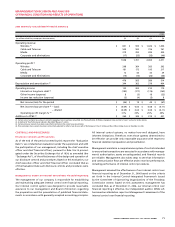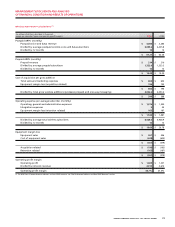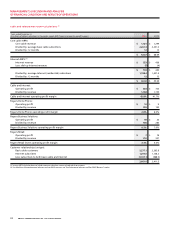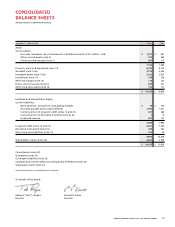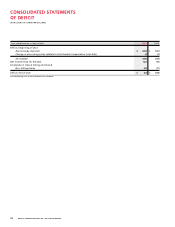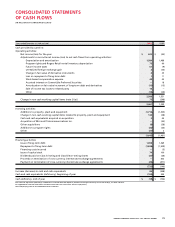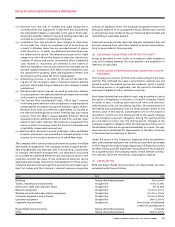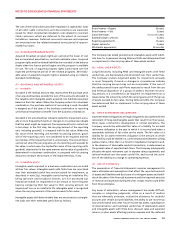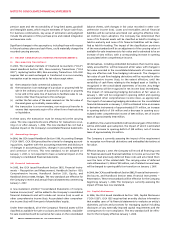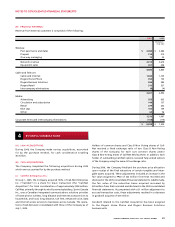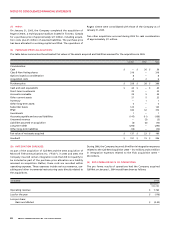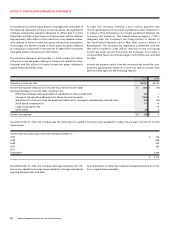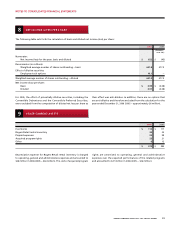Rogers 2006 Annual Report Download - page 85
Download and view the complete annual report
Please find page 85 of the 2006 Rogers annual report below. You can navigate through the pages in the report by either clicking on the pages listed below, or by using the keyword search tool below to find specific information within the annual report.
81
RO GER S CO MMU NIC AT ION S IN C . 20 0 6 ANN UA L RE POR T
NOTES TO CONSOLIDATED FINANCIAL STATEMENTS
(iii) Revenue from the sale of wireless and cable equipment is
recorded when the equipment is delivered and accepted by
the independent dealer or subscriber in the case of direct sales.
Equipment subsidies related to new and existing subscribers are
recorded as a reduction of equipment revenues;
(iv) Installation fees and activation fees charged to subscribers
do not meet the criteria as a separate unit of accounting. As
a result, in Wireless these fees are recorded as part of equip-
ment revenue or, in Cable, are deferred and amortized over
the related service period. The related service period for Cable
ranges from 26 to 48 months, based on subscriber disconnects,
transfers of service and moves. Incremental direct installation
costs related to reconnects are deferred to the extent of
deferred installation fees and amortized over the same period
as these related installation fees. New connect installation costs
are capitalized to property, plant and equipment (“PP&E”) and
amortized over the useful life of the related assets;
(v) Advertising revenue is recorded in the period the advertis-
ing airs on the Company’s radio or television stations and the
period in which advertising is featured in the Company’s media
publications;
(vi) Monthly subscription revenues received by television stations
for subscriptions from cable and satellite providers are recorded
in the month in which they are earned;
(vii) The Toronto Blue Jays Baseball Club’s (“Blue Jays”) revenue
from home game admission and concessions is recognized as the
related games are played during the baseball regular season.
Revenue from radio and television agreements is recorded at
the time the related games are aired. The Blue Jays also receive
revenue from the Major League Baseball Revenue Sharing
Agreement which distributes funds to and from member clubs,
based on each club’s revenues. This revenue is recognized in the
season in which it is earned, when the amount is estimable and
collectibility is reasonably assured; and
(viii) Multi-product discounts incurred as Wireless, Cable and Media
products and services are provided are charged directly to the
revenue for the products and services to which they relate.
The Company offers certain products and services as part of multiple
deliverable arrangements. The Company divides multiple deliver-
able arrangements into separate units of accounting. Components
of multiple deliverable arrangements are separately accounted
for provided the delivered elements have stand-alone value to the
customers and the fair value of any undelivered elements can be
objectively and reliably determined. Consideration for these units is
measured and allocated amongst the accounting units based upon
their fair values and the Company’s relevant revenue recognition
policies are applied to them. The Company recognizes revenue once
persuasive evidence of an arrangement exists, delivery has occurred
or services have been rendered, fees are fixed and determinable and
collectibility is reasonably assured.
Unearned revenue includes subscriber deposits, installation fees and
amounts received from subscribers related to services and subscrip-
tions to be provided in future periods.
(D) SUBSCRIBER ACQUISITION AND RETENTION COSTS:
Except as described in note 2(c)(iv), as it relates to cable installation
costs, the Company expenses the costs related to the acquisition or
retention of subscribers.
(E) STOCK-BASED COMPENSATION AND OTHER STOCK- BASED
PAYMENTS:
The Company accounts for all stock option plans using the fair value
method. The estimated fair value is amortized to expense over the
period in which the related services are rendered, which is usually
the vesting period or, as applicable, over the period to the date an
employee is eligible to retire, whichever is shorter.
Stock-based awards that are settled in cash, may be settled in cash at
the option of employees or directors, or that the Company intends
to settle in cash, including restricted stock units and directors’
deferred share units, are recorded as liabilities. The measurement of
the liability and compensation cost for these awards is based on the
intrinsic value of the awards. Compensation cost for the awards is
recorded in income over the vesting period of the award. Changes
in the Company’s payment obligation during the vesting period
are recorded in income over the vesting period. Changes in the
Company’s payment obligation after the vesting period but prior to
the settlement date are recognized immediately in income. The pay-
ment amount is established for these awards on the date of exercise
of the award by the employee or director.
Under the terms of the Company’s employee share accumulation
plan, participating employees can contribute a specified percentage
of their regular earnings through regular payroll deductions which
are then used to purchase Class B Non-Voting shares of the Company.
On a quarterly basis, the Company makes certain defined contribu-
tion matches, which are recorded as compensation expense.
(F) DEPRECIATION:
PP&E and Rogers Retail rental inventory are depreciated over their
estimated useful lives as follows:
Asset Basis Rate
Buildings Mainly diminishing balance 5% to 62/3%
Towers, headends and transmitters Straight line 62/3% to 25%
Distribution cable and subscriber drops Straight line 5% to 20%
Network equipment Straight line 62/3% to 331/3%
Wireless network radio base station equipment Straight line 121/2% to 141/3%
Computer equipment and software Straight line 141/3% to 331/3%
Customer equipment Straight line 20% to 331/3%
Leasehold improvements Straight line Over shorter of estimated
useful life and lease term
Rogers Retail rental inventory Mainly diminishing balance 6 months
Other Mainly diminishing balance 20% to 331/3%


